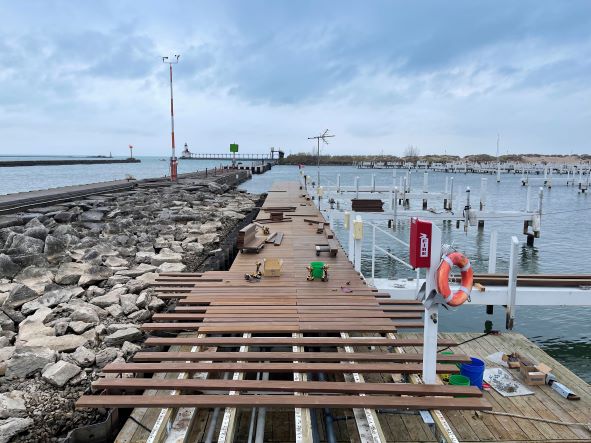
Marina Renovation Strategies
Published on February 18, 2022There are many reasons marina owners consider renovation projects at their facilities, including safety, managing liability, maintaining efficient operations, responding to changing environmental conditions, and modernizing facilities to maintain their competitive edge to name a few. Renovations can range from a simple bathroom upgrade to a complete reconstruction of the marina. In every case, it is important to have a clear understanding of the long-term vision for the facility to ensure every penny invested in the marina is well spent and cost-effective.
Create a Master Plan
We recommend marina owners create a master plan vision for the future of their facilities that is updated every five to 10 years to be sure the marina infrastructure is capable of serving a changing marina market. The plan doesn’t have to be elaborate, but it should answer several key questions, such as:
- Are the boats in my market changing? Are they getting longer? Wider? Will the docks I have today accommodate the boats we’ll see in five years?
- Are my electrical utilities keeping up with increasing demand from newer boats? Are my electrical systems safe and up to code, and are my ground fault protection systems working properly?
- Are there any areas in the marina that are potential safety hazards, or that might be creating liability issues that increase our insurance rates? Are we ADA compliant?
- Can the marina be reorganized to reduce staffing requirements? Can fuel dock staff work in guest services or in the ship’s store? Can we reorganize the slip layout to add more slips, or change the slip size mix to service more profitable boats?
- Are water levels changing in my marina? Do I need to plan for more dredging, or are my wave attenuation systems starting to have trouble keeping up with larger waves and bigger storms?
- How much longer will my dock systems last, and do I have a plan for replacing them in an orderly way so I don’t have to close the marina during boating season, or minimize disruption in facilities open year-round?
- Are my competitors adding amenities or making improvements that make their marinas more desirable than mine? Is there something we can add to our facility to set us apart from the competition?
While there are many more considerations you might want to add to the list above, the idea is to think long-term to establish the big picture vision first. Once you have a clear idea of where you want your facility to be in five to 10 years, it’s time to determine the best way to get there by setting priorities and estimating costs, and determining if there are projects that make more economic sense to combine rather than tackle as separate projects.
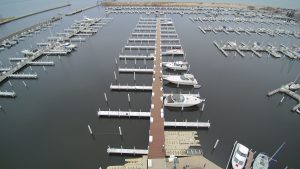
Washington Park Marina
The Michigan City Port Authority in northwest Indiana operates Washington Park Marina, a beautiful 550+ slip marina located on the shores of Lake Michigan. The facility utilizes an adjustable fixed dock system and the time had come to update and modernize their electrical systems. While it would have been possible to replace all the conduit, wiring, and pedestals from the underside of the dock system, by combining the electrical upgrades with a decking replacement project, the Port Authority saved time and money on both projects by completing them together as a single project. To manage costs and minimize any potential disruption to marina operations, the project was implemented in a series of phases, with each being able to be completed in the offseason. The old decking was removed and the electricians had free reign to work as efficiently as possible. The new Kebony decking (a very high-quality pine product with a 30-year lifespan) was then installed, bringing new life to an aging marina. While obviously a major investment, the facility is working towards being one of the safest and lowest maintenance marinas on Lake Michigan and will remain so for decades to come.
Northside Marina
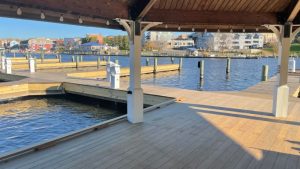
In South Haven, Michigan, the City operates several facilities on the Black River that were severely impacted by recent record high water levels on the Great Lakes. At the City’s Northside Marina facility, the fixed docks and electrical systems were often submerged, and shoreline protection systems were failing. Adjacent upland parking and landscape areas were subsiding as water levels overtopped rock revetment edges, creating safety and maintenance issues. The electrical issues required closure of the nearly 100 slip marina due to safety concerns in the summer of 2020, which coincided with the onset of the COVID pandemic. With multiple facilities, the City did not need to consider any major changes in the slip configuration or slip mix, so they focused on an emergency overhaul of the facility that included raising the entire fixed dock system, replacement of all electrical utilities, new decking, new steel sheet pile reinforcement of the rock revetment walls, and raising the promenade along the Black River. With emergency grant funding from the State of Michigan, the project was completed in two phases through a design-build process. The 87 slips in the main marina were completed in 12 months start to finish, with final improvements to the marina walls, promenade, and remaining slips finishing six months later.
Harrisville Harbor
So what do you do if you aren’t lucky enough to receive a seven-figure emergency grant to renovate your marina? That’s when establishing priorities and phasing becomes critical. Harrisville Harbor is a municipal marina of 90 slips located on Lake Huron. With a mix of fixed and floating docks, the facility had experienced significant ice damage in addition to simple wear and tear from age. The utility systems were out of date, inadequate to current demand, and lacking modern ground fault protection. Despite the age of the facility, marina staff earned a reputation on Lake Huron for keeping everything neat and clean and working as well as possible. The challenge is that once you get behind on infrastructure, you end up spending all your time and money trying to keep your head above water rather than responding to a changing marina market.
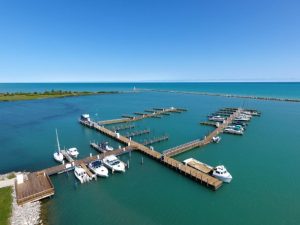
Harrisville Harbor staff created a vision for the marina that would see the slip mix updated to respond to current boating demand, replace aging floating docks that were past their useful life, bring all utilities up to current codes, and dredge to restore navigation depths. The fuel dock and decking on the fixed docks were replaced, and new gangways addressed ADA compliance issues.
With the plan in hand, the only challenge was finding the money to make it happen. As a Grant-in-Aid facility, the Michigan Department of Natural Resources was able to provide funding assistance for the needed renovations, but only in small amounts. With 87 facilities either owned by MDNR or funded through the Grant-in-Aid program, MDNR has a large backlog of marina capital improvement needs every year and has the same funding challenges government agencies all across the country face.
In Harrisville, the solution was to implement the master plan in five small phases over a span of five years. With two sets of floating docks, in one early phase the harbor worked with the dock builder to replace the main pier on one dock and re-use all of the finger piers that were still serviceable. Dock segments that were no longer safe were removed, and the best parts and pieces of the existing docks were combined to keep as many slips as possible in service. New dock segments were installed in consideration of electrical runs to maximize the efficiency of installation of new systems and to ensure core safety systems were installed in early phases. In the following phases the floating docks were extended to increase capacity. A similar process was used on the other main dock once the first was operational. Over time older fingers were replaced, and later phases upgraded the fuel dock, fuel system, and fixed dock decking. While there were many logistical challenges in managing the process, and it would have been less expensive to do everything in one phase, there was no other way to fund the project. Today the marina is in better shape than ever and fully reopened to the public.
Evaluate & Prioritize Upgrades
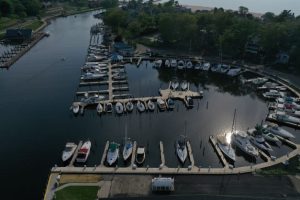
Few private facilities have the funding capacity to implement a complete overhaul in a single phase, so it is even more important to make sure every investment leads to lower maintenance or operational costs, or immediately makes the facility more desirable to boaters. When evaluating priorities, it is important to engage your boaters to be sure you understand what is most important to them. In our surveys of thousands of boaters across the Great Lakes, the items that nearly always rise to the top of the list from the boater perspective are improvements to bathrooms and showers, electrical utility capacity and reliability, and Wi-Fi performance. If you’re having trouble deciding which to do first, engage your boaters to see what matters most to them. If you can’t afford to get to important upgrades right away, don’t underestimate the importance of friendly staff and keeping everything as neat and clean as possible. We have found that most boaters both respect and appreciate marinas where the staff is visibly working hard to make the most of what they have to offer, and that effort goes a long way to keep your customers happy.
Rate Increases & Renovations
One final recommendation is to combine rate increases with renovation projects. While no one wants to see their slip fees go up, it is easier to accept when there are obvious renovation projects underway. Everyone understands that new facilities cost a lot of money, and while there will always be complaints about rising costs, most boaters value quality facilities. Once you get into a positive cycle of improving your facilities and charging appropriately higher rates, it supports your ability to maintain your facilities at a higher quality level over time. Over time, you will become more competitive, safer, less expensive to operate and maintain, and more desirable to your customers.
| Categories | |
| Tags |






